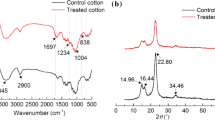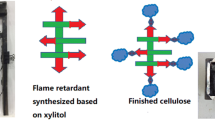Abstract
Bio-resourced mannitol was employed to synthesize eco-friendly ammonium salt of mannitol hexaphosphate acid ester (AMHPE) by facile, solvent-free tactics. Limiting oxygen index (LOI) of cotton treated with 20–30% AMHPE reached 36.0–42.3% to obtain high-efficiency flame retardancy. After 50 laundering cycles, the LOI value of 30% AMHPE treated cotton still retains an LOI value of 27.9%, revealing outstanding durability owing to new P–O–C covalent bonds formed bewteen –P = O(ONH4)+2 groups of AMHPE and cotton. The decomposition temperature of treated cotton was significantly lowered and its char residue was much higher than control cotton in N2. The PHRR and THR values of treated cotton were notably declined to 93.41% and 56.54% respectively, and the residual is 28 times higher by contrast. The combustion products and flame retardant mechanism of treated cotton were analyzed by TG-IR and cone calorimetry. These results indicate that AMHPE flame retardant cotton has acquired efficient flame retardancy, excellent durability and thermostability.
Graphic abstract
Solvent-free synthesis of bio-resourced N–P synergetic flame retardant possessing excellent flame retardancy, unexceptionable durability and thermostability to reduce cotton fire hazard.








Similar content being viewed by others
References
Alongi J, Colleoni C, Rosace G, Malucelli G (2014) Sol-gel derived architectures for enhancing cotton flame retardancy: effect of pure and phosphorus-doped silica phases. Polym Degrad Stab 99:92–98
Basak S, Ali SW (2018) Fire resistant behaviour of cellulosic textile functionalized with wastage plant bio-molecules: a comparative scientific report. Int J Biol Macromol 114:169–180
Blas-Sevillano RH, Veramendi T, La Torre B, Velezmoro-Sanchez CE, Oliva AI, Mena-Martinez ME, Cervantes-Uc JM (2018) Physicochemical characterization of several types of naturally colored cotton fibers from Peru. Carbohydr Polym 197:246–252
Chen XL, Ma CY, Jiao CM (2016) Enhancement of flame-retardant performance of thermoplastic polyurethane with the incorporation of aluminum hypophosphite and iron-graphene. Polym Degrad Stab 129:275–285
Chen ZH, Dong CH, Li Q, Pu Y, Lu Z (2018) Multifunctional, hydrophobic and flame-retarded cotton fabrics modified with liner piperzine/phosphorous/polysiloxane copolymer. Fibers Polym 19(4):861–867
Fang F, Chen XX, Zhang X, Cheng C, Xiao DZ, Meng YD, Tian XY (2016) Environmentally friendly assembly multilayer coating for flame retardant and antimicrobial cotton fabric. Prog Org Coat 90:258–266
Gao WW, Zhang GX, Zhang FX (2015) Enhancement of flame retardancy of cotton fabrics by grafting a novel organic phosphorous-based flame retardant. Cellulose 22(4):2787–2796
Gao JD, Sun W, Hu YH, Wang L, Liu RQ, Gao ZY, Lyu F (2019) Propyl gallate: a novel collector for flotation separation of fluorite from calcite. Chem Eng Sci 193:255–263
Jeong DG, Cha JM, Ryu BK (2018) Study on the synthesis of Fe2O3-, MgO-cored glass by sol-gel method and their application in agricultural chemistry. J Sol-Gel Sci Technol 87(3):593–599
Jiao CM, Wang HZ, Chen XL (2018) Preparation of modified fly ash hollow glass microspheres using ionic liquids and its flame retardancy in thermoplastic polyurethane. J Therm Anal Calorim 133(3):1471–1480
Jing J, Zhang Y, Tang XL, Zhou Y, Li XN, Kandola BK, Fang ZP (2017) Layer by layer deposition of polyethylenimine and bio-based polyphosphate on ammonium polyphosphate: a novel hybrid for simultaneously improving the flame retardancy and toughness of polylactic acid. Polymer 108:361–371
Kim NK, Lin RJT, Bhattacharyya D (2015) Effects of wool fibres, ammonium polyphosphate and polymer viscosity on the flammability and mechanical performance of PP/wool composites. Polym Degrad Stab 119:167–177
Kim S, Shimazu J, Fukaminato T, Ogata T, Kurihara S (2017) Thermal conductivity of graphene oxide-enhanced polyvinyl alcohol composites depending on molecular interaction. Polymer 129:201–206
Konig A, Kroke E (2012) Flame retardancy working mechanism of methyl-DOPO and MPPP in flexible polyurethane foam. Fire Mater 36(1):1–15
Kwak WG, Oh MH, Gong MS (2015) Preparation of silver-coated cotton fabrics using silver carbamate via thermal reduction and their properties. Carbohydr Polym 115:317–324
Laoutid F, Bonnaud L, Alexandre M, Lopez-Cuesta JM, Dubois P (2009) New prospects in flame retardant polymer materials: from fundamentals to nanocomposites. Mater Sci Eng R-Rep 63(3):100–125
Li XW, Feng YZ, Chen C, Ye YS, Zeng HX, Qu H, Xie XL (2018) Highly thermally conductive flame retardant epoxy nanocomposites with multifunctional ionic liquid flame retardant-functionalized boron nitride nanosheets. J Mater Chem A 6(41):20500–20512
Lin DM, Zeng XR, Li HQ, Lai XJ, Wu TY (2019) One-pot fabrication of superhydrophobic and flame-retardant coatings on cotton fabrics via sol-gel reaction. J Colloid Interface Sci 533:198–206
Liu XH, Zhang QY, Cheng BW, Ren YL, Zhang YG, Ding C (2018a) Durable flame retardant cellulosic fibers modified with novel, facile and efficient phytic acid-based finishing agent. Cellulose 25(1):799–811
Liu Y, Wang QQ, Jiang ZM, Zhang CJ, Li ZF, Chen HQ, Zhu P (2018b) Effect of chitosan on the fire retardancy and thermal degradation properties of coated cotton fabrics with sodium phytate and APTES by LBL assembly. J Anal Appl Pyrol 135:289–298
Mandlekar N, Malucelli G, Cayla A, Rault F, Giraud S, Salaun F, Guan JP (2018) Fire retardant action of zinc phosphinate and polyamide 11 blend containing lignin as a carbon source. Polym Degrad Stab 153:63–74
Ortelli S, Malucelli G, Cuttica F, Blosi M, Zanoni I, Costa AL (2018) Coatings made of proteins adsorbed on TiO2 nanoparticles: a new flame retardant approach for cotton fabrics. Cellulose 25(4):2755–2765
Pan HF, Wang W, Pan Y, Song L, Hu Y, Liew KM (2015) Formation of self-extinguishing flame retardant biobased coating on cotton fabrics via Layer-by-Layer assembly of chitin derivatives. Carbohydr Polym 115:516–524
Pan Y, Liu LX, Zhang YP, Song L, Hu Y, Jiang SD, Zhao HT (2019) Effect of genipin crosslinked layer-by-layer self-assembled coating on the thermal stability, flammability and wash durability of cotton fabric. Carbohydr Polym 206:396–402
Poon CK, Kan CW (2015) Effects of TiO2 and curing temperatures on flame retardant finishing of cotton. Carbohydr Polym 121:457–467
Shafizadeh F, Bradbury AGW, Degroot WF, Aanerud TW (1982) role of inorganic additives in the smoldering combustion of cotton cellulose. Ind Eng Chem Prod Res Dev 21(1):97–101
Shao ZB, Deng C, Tan Y, Chen MJ, Chen L, Wang YZ (2014a) An efficient mono-component polymeric intumescent flame retardant for polypropylene: preparation and application. ACS Appl Mater Interfaces 6(10):7363–7370
Shao ZB, Deng C, Tan Y, Yu L, Chen MJ, Chen L, Wang YZ (2014b) Ammonium polyphosphate chemically-modified with ethanolamine as an efficient intumescent flame retardant for polypropylene. J Mater Chem A 2(34):13955–13965
Tian CY, Wang CY, Ren XN, Hong L (2019) Synthesis of silane-modified polyphosphate esters and its application in transparent flame-retardant coatings. J Appl Polym Sci 136(11):47199
Wang W, Zammarano M, Shields JR, Knowlton ED, Kim I, Gales JA, Li JZ (2018) A novel application of silicone-based flame-retardant adhesive in plywood. Constr Build Mater 189:448–459
Wu HY, Hu R, Zeng BR, Yang L, Chen T, Zheng W, Dai LZ (2018) Synthesis and application of aminophenyl-s-triazine derivatives as potential flame retardants in the modification of epoxy resins. RSC Adv 8(66):37631–37642
Xie KL, Gao AQ, Zhang YS (2013) Flame retardant finishing of cotton fabric based on synergistic compounds containing boron and nitrogen. Carbohydr Polym 98(1):706–710
Yang H, Yang CQ (2005) Durable flame retardant finishing of the nylon/cotton blend fabric using a hydroxyl-functional organophosphorus oligomer. Polym Degrad Stab 88(3):363–370
Yang ZY, Wang XW, Lei DP, Fei B, Xin JH (2012) A durable flame retardant for cellulosic fabrics. Polym Degrad Stab 97(11):2467–2472
Zhao DQ, Deng Y, Han DL, Tan LL, Ding Y, Zhou ZG, Guo YX (2019) Exploring structural variations of hydrogen-bonding patterns in cellulose during mechanical pulp refining of tobacco stems. Carbohydr Polym 204:247–254
Acknowledgments
The research was supported by Chongqing postgraduate education and teaching reform major project (No: yjg152022).
Author information
Authors and Affiliations
Corresponding authors
Ethics declarations
Conflicts of interest
There are no conflicts to declare.
Additional information
Publisher's Note
Springer Nature remains neutral with regard to jurisdictional claims in published maps and institutional affiliations.
Electronic supplementary material
Below is the link to the electronic supplementary material.
Rights and permissions
About this article
Cite this article
Zhang, F., Lu, Y., Wan, C. et al. A bio-resourced mannitol phospholipid ammonium reactive flame retardant for cotton with efficient antiflaming and durability. Cellulose 27, 4803–4815 (2020). https://doi.org/10.1007/s10570-020-03064-2
Received:
Accepted:
Published:
Issue Date:
DOI: https://doi.org/10.1007/s10570-020-03064-2




